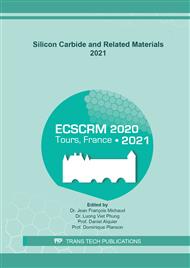p.44
p.49
p.54
p.59
p.64
p.69
p.74
p.79
p.84
Effect of N and Al Doping on 3C-SiC Stacking Faults
Abstract:
This study offers a comprehensive examination of the behavior of 3C-SiC crystals grown on 4° off-axis (100) Si substrates with different off-axis angles along <110> and <100> for N and Al doping, respectively. The investigation takes advantage of molten KOH etching to conduct an in-depth investigation of the average density and size of the SFs inside the crystal for both n- and p-type doped 3C-SiC epitaxial layers. Moreover, 3C-SiC grown on a <100> off-cut substrate was revealed to have a greater concentration of SFs due to the absence of self-annihilation along the plane (-1-10). Considering two different doping ranges suitable for IGBTs and MOSFETs development, the impact of doping and off-angle on the crystal quality, concentration, and length distribution of SFs was then investigated in order to quantify the influence of N and Al incorporation on the structural and optical characteristics of the semiconductor. It turned out that under heavy nitrogen doping (~1019 cm-3), when the dopant concentration grew, the average length of the stacking faults (SFs) expanded while their density dropped.
Info:
Periodical:
Pages:
64-68
Citation:
Online since:
May 2022
Keywords:
Permissions:
Share:
Citation:


